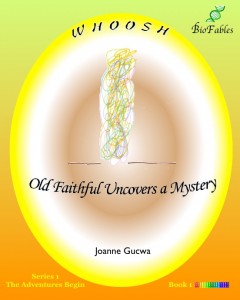 “Race ya.”
The sun was barely peeking over the horizon at Yellowstone National Park when Melody shouted this unexpected challenge to her twin brother Mallory.
“No fair. You got a head start!”
A head start was exactly what Melody had in mind. She wanted to make sure Mallory didn’t reach Old Faithful before she did. (He didn’t)
“Race ya.”
The sun was barely peeking over the horizon at Yellowstone National Park when Melody shouted this unexpected challenge to her twin brother Mallory.
“No fair. You got a head start!”
A head start was exactly what Melody had in mind. She wanted to make sure Mallory didn’t reach Old Faithful before she did. (He didn’t)
If 7-year-old Melody Maloney had been standing anywhere else or  at any other time, this would have been an ordinary adventure story. But nature has a way of behaving that doesn’t always follow the rules.
at any other time, this would have been an ordinary adventure story. But nature has a way of behaving that doesn’t always follow the rules.
What happens when the Old Faithful Geyser at Yellowstone decides to misbehave? Melody and her twin brother Mallory find out, but no one believes them.
Why is the world’s first National Park the site for this first book in the BioFables series? Well, besides its famous geysers, Yellowstone shows off the exotic colors of its hot springs. What’s so special about that? Those bright blues, yellows, pinks and other colors are thanks to extremophiles, the heat-loving variety of extremophile microbes that live in the steaming waters. So what? Glad you asked. Scientists agree that only microbes are classified as extremophiles. But Melody and her 7-year-old brother Mallory discover that one of them might also be an extremophile. Whoosh is, after all, a work of fiction, and human extremophile instances are the BioFables series’ only departure from legitimate science.
BioFables children’s books focus on illuminating Sciences (STEM: Science, Technology, Engineering, Math) principles through fun stories. Parents, you know from experience that learning the subject matter that we call Sciences is a good first step. Understanding Humanities subjects helps us know how best to apply Sciences principles to the practical needs of the external world. And understanding one’s internal Values/Behaviors helps us to make things happen.
Every BioFables book weaves lessons derived from these interconnected (and often hidden) core disciplines into realistic stories that children relate to. Parents, you can use the free resources of this site to uncover those nearly-invisible lessons. They will help you prepare your children for happy, productive, rewarding and well-balanced lives.
If you’d like to purchase Whoosh, please click on the Buy Whoosh icon to go directly to Barnes and Nobles’ Whoosh page. Your purchase of Whoosh helps support our ongoing efforts to continue expanding the wealth of  this site’s free resources for homeschooling and all parents who are dedicated to the intellectual growth of their children.
this site’s free resources for homeschooling and all parents who are dedicated to the intellectual growth of their children.
If you’d like to learn more about using the considerable Whoosh resources at this site, please read on.
Whoosh Resources
The ten chapters in Whoosh contain nearly a hundred practical mini-lessons and pop-up lessons woven throughout Whoosh. We call these practical lessons Knowledge Nuggets. These Knowledge Nuggets contain specific information that readers can apply to their everyday lives. They may be in the form of a mini-lesson, with simple explanations of a specific concept, or as a quick, unplanned pop-up lesson.
You will find that many of these Knowledge Nugget lessons are in stealth mode. This is true especially in the Humanities and Values/Behaviors Core Disciplines, where common family experiences in Whoosh offer lessons that might easily be missed.
Homeschooling parents often want to know where the specific Knowledge Nugget lessons fit into more general learning classifications. To address that need, we’ve designed a 5-tier structure for all BioFable books, ranging from the most general (Core Disciplines) to the most specific (Knowledge Nuggets) catgories:
-
- 1. Core Disciplines: Sciences, Humanities, Values/Behaviors
- 2. Knowledge Gateways (Color-coded examples: Earth/Space Science, History, Spirit)
- 3. Discovery Paths (Example: Geology, a Discovery Path of Earth/Space Science)
- 4. Discovery Path Branches (Example: Geysers, a Discovery Path Branch of Geology)
- 5. Knowledge Nuggets: Specific mini- or pop-up lessons (Example: Geyser ingredients)
- 4. Discovery Path Branches (Example: Geysers, a Discovery Path Branch of Geology)
- 3. Discovery Paths (Example: Geology, a Discovery Path of Earth/Space Science)
- 2. Knowledge Gateways (Color-coded examples: Earth/Space Science, History, Spirit)
- 1. Core Disciplines: Sciences, Humanities, Values/Behaviors
So, starting from the “Geyser ingredients” Knowledge Nugget mini-lesson, you can follow its order back to its Core Discipline (Sciences):
-
- Geyser ingredients (Knowledge Nugget)
- Geysers (Discovery Path Branch)
- Geology (Discovery Path)
- Earth/Space Science (Knowledge Gateway)
- Sciences (Core Discipline)
- Earth/Space Science (Knowledge Gateway)
- Geology (Discovery Path)
- Geysers (Discovery Path Branch)
- Geyser ingredients (Knowledge Nugget)
Click –> Whoosh Knowledge Gateways <– to access four sets of tables and lists that help you to place a given Knowledge Nugget within the greater realm of learning. As shown in both two 5-tier structures above, the three Core Disciplines and their associated Knowledge Gateways share the same Red, Blue and Purple color. We’ve not added colors to the terms in the more detailed tiers because these terms can be applied in different Core Cisciplines or Knowledge Gateways. An example: Geysers may appear in the context of a History lesson (Humanities), rather than in a Geology (Sciences) lesson.
